How the Alternate Side Lives
The challenges of parking a car in New York City
by Alex Dworkowitz
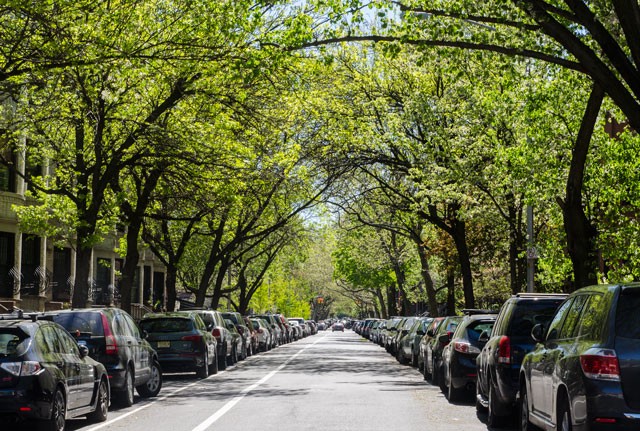
Mary Norris doesn’t want other people to know where the block she dubs “the Sanctuary” is located, so I won’t provide the key details. But, like most streets in Manhattan, twice a week, parking is prohibited on each side of the Sanctuary under the “alternate-side parking” program, which allows New York Department of Sanitation sweepers to clean the curb. Unlike most other city blocks, however, the ban only lasts half an hour, instead of the usual hour and a half, giving Norris plenty of time to get to work by 10 a.m. Moreover, in a rarity for Manhattan, the Sanctuary is a cul-de-sac, and one not easily accessed from the main street grid. Its out-of-the-way location also makes it a pain for both street sweepers and traffic police to access, so Norris is unlikely to be forced to move or be ticketed once she finds a spot.
“It’s my favorite place of all time,” Norris told me one day this past winter, as we toured parking spaces in her East Side neighborhood. As we walked, she noticed that there was plenty of space between a nearby car and a fire hydrant — well more than the fifteen-foot gap required by law. “I can’t help but look for a spot even though I don’t have my car here,” she said. (Her 1990 Honda Civic was on loan to a friend in the Rockaways.) Later, she pointed out a new smart car on the street. “There’s a great parking car,” she said.
Norris is a long-time copy editor at the New Yorker, and, as required by the job, an expert grammarian. Parking is her other obsession. A Cleveland native, Norris moved to New York from Vermont in 1977. During her first week in town, she received two hundred dollars in traffic tickets. She gave her car up for a decade afterward; her current study of parking is partially an attempt to master an art that once eluded her. In 2007, she started a blog called “The Alternate Side Parking Reader,” which has covered topics like the optimal time of day to find a parking spot, getting her car towed by a “Sex and the City” film crew, and earning bathroom privileges at a local Greek restaurant after helping a waiter squeeze into a spot. “Some people think it’s a dull subject,” Norris said. “But I never tire of it. It’s like grammar.”
Norris is one of many New Yorkers who have a quiet fascination with the challenges of parking a car in the city. Jerry Seinfeld, Larry David, and Greg Daniels poked fun of the city’s parking culture in two early episodes of Seinfeld. Author Calvin Trillin wrote an entire novel, Tepper Isn’t Going Out, about a man who just wants to sit in his parking space in peace. Even Horst Störmer, a Columbia University professor who won a Nobel Prize in physics, has pontificated on the best techniques to finding a parking space in New York City.
The City of New York does not keep data on the number of residents who park their cars on the streets, but some sources suggest that it’s a large group of people. There are approximately 1.8 million cars registered in New York City. While many are kept in garages, driveways, or parked on the streets of more suburban outer borough neighborhoods — where finding a parking spot is rarely an issue — if just a third of the city’s registered vehicles are kept on the streets of the more densely packed neighborhoods, then six hundred thousand people depend on the city’s graces for parking.

When cars were first produced at the turn of the twentieth century, they were seen as a replacement for the horse and buggy; it was expected that only the wealthy would own cars, which would be stored in their carriage houses, so there was little concern about where to put them when not in use. With the advent of the Model T and other, more affordable cars, however, middle-class people who did not own garages began buying them, and by the late twenties and early thirties, parked vehicles were a common sight on New York City streets.
City officials blamed parking for promoting a constant stream of menace: Parked cars served as hiding places for holdup men, a means of escape for bank robbers, a hurdle to sanitation men, a cause of traffic congestion, and, above all, a fire hazard. Not only did parked cars make it difficult for fire trucks to get by, but their gasoline tanks could explode if ignited. The Chief Magistrate of the Traffic Court, charged with punishing violators of the city’s traffic laws, viewed street parking as an “intolerable and dangerous nuisance”; the City’s Fire Commissioner called it “a distinct menace to life and property”; and newspaper editorial pages routinely referred to it as an “evil” that needed to be addressed.
For others, parked cars were less a danger than an eyesore. “It is unpleasant to have a car, usually an old dilapidated one, in front of one’s windows,” a Manhattan resident wrote to the New York Times in 1935, contending that the “streets of New York were never intended for garage purposes.” Later that year, a feud between a doctor and a banker on the Upper East Side made headlines when the doctor sued his neighbor, accusing the banker of vandalizing his car. The banker, upset at the doctor’s habit of leaving his car in front of the banker’s house for long periods of time, had attached a series of sarcastic stickers on the doctor’s windshield. (“Do Not Open Until Christmas,” one read..)
Responding to the anger directed at parked cars, the city issued regulations in 1927 that codified a practice of limiting parking to one hour in business areas. Critically, the regulation also imposed a three-hour time limit throughout the city on parking between the hours of midnight and 7 a.m. The message was clear: anyone with a car needed a place to store it at night.
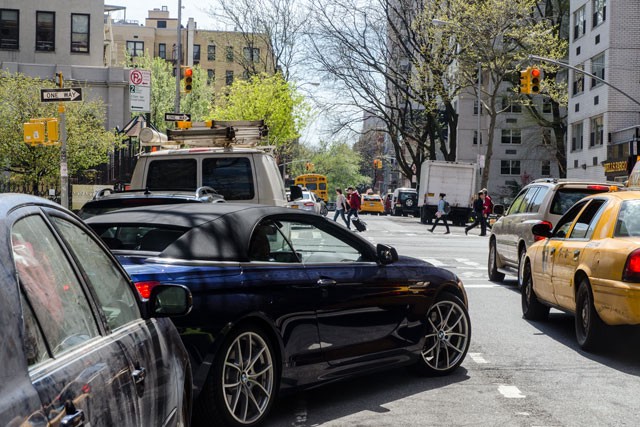
Parking regulations were applied arbitrarily from the start. New Yorkers accused police of accepting bribes to ignore violations and of looking the other way when customers of favored businesses parked in front of those shops, while others faced the full brunt of the law. In 1927, seven residents of Harlem and the Bronx were given jail sentences for keeping their cars parked on the streets, though the sentences were converted to fines after the Chief Magistrate found that the sentencing judge had discriminated against the seven parkers because they were black.
The time limits also proved difficult to enforce. A violation required the police to prove that a car was parked in a particular spot in excess of the given time limit, and New Yorkers grew savvy to the challenges of doing so. A group of Columbia University students took turns moving their shared car in the middle of the night in order to avoid breaking the three-hour limit. An advice column suggested that drivers check their tires in the morning and remove any chalk marks to frustrate the police’s time-tracking system. Just as infuriating for police was the requirement — which was not modified until 1933 — that motorists be personally served with a summons for all parking violations. Even when the police, undermanned and overburdened, could track down a parking violator, they were often reluctant to punish people during the height of the Great Depression, when many clearly had no alternative to on-street parking. Judges, however, were frequently less merciful. When a salesman told a magistrate in 1933 that he parked in front of his East Village home because he could not afford a garage, the judge chastised him and imposed a fine, telling him, “A man with your nerve would buy a portable bungalow, put it up in the street and live there rent free.”
Judicial lectures and police crackdowns, however, were not enough to combat the growing number of cars. The time-limit system finally came to an end in the early nineteen fifties. Parking meters were installed in business areas, rendering the one-hour commercial limit rule moot. In 1952, Mayor Vincent Impellitteri proposed that New York City end the ban on overnight parking by establishing a system of residential parking permits with an annual fee of sixty dollars per permit. The State Legislature approved, but the Board of Estimate, the city’s primary legislative body at the time, declined to adopt the change. Two years later, the city, finally recognizing the reality that overnight street parking was not going away, dropped the three-hour time limit, and parking was effectively legalized on most city streets.

Around the time that New York’s parking ban came to an end, complaints about the filthy condition of the city’s street curbs had become common; tightly packed together cars made it difficult for sanitation workers to reach the refuse with their brooms. Sanitation Department officials proposed an experiment: require car owners to clear their cars from one side of the street at a time, so that vehicles with brooms attached to their bellies could sweep up the curbside trash. On August 1, 1950, a team of policemen, cleaning vehicles (known as street sweepers or mechanical brooms), tow trucks, and three hundred and fifteen welfare recipients acting as “parking wardens” descended on the East Village (then called part of the Lower East Side) because a Health Department survey found it to be extensively littered. From 7 a.m. to 3 p.m., they issued summons to motorists who did not remove their cars in time, hauled away vehicles that blocked the path of the mechanical brooms, and cleaned the streets.
One day later, the Sanitation Department declared the alternate-side program a success, contending the neighborhood had not been that tidy in many years. The program was brought to other parts of the neighborhood over the following months. By 1955, the program was in effect throughout Manhattan, with curbs typically being cleaned three times a week; it soon expanded to many neighborhoods in the outer boroughs.
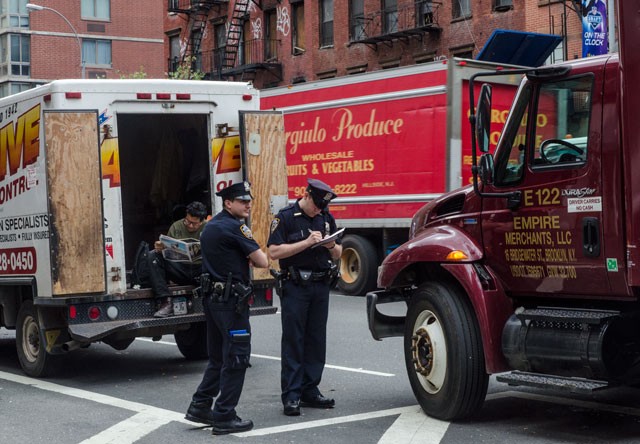
More than sixty years later, the system remains largely the same. In most neighborhoods, at certain times on specific days of the week, cars are forbidden from parking on one side of the street to allow street sweepers to pull up to the curb and spray it with water while the rotating brooms sweep refuse into the vehicle’s hopper. Parking is forbidden on the opposite side of the street on other days, so that side can be cleaned. Drivers need to switch back and forth between each side of the street depending on the day of the week — hence the name, “alternate-side parking.” When parking is banned, traffic cops give out tickets to illegally parked cars at sixty five dollars per violation; the cars of repeat offenders also can be towed.
New York remains an outlier in terms of how often it cleans its streets. After discovering that cleaning each side of the street three times a week was generally not necessary, the city reduced the frequency to twice a week in the early nineties — and some neighborhoods with a high “cleanliness rating” are swept just once a week. Other major cities, like Dallas, Philadelphia and Seattle, don’t bother with regularly cleaning residential areas. Those that do, such as San Francisco and Boston, typically sweep each side of residential streets twice a month — one fourth as often as in much of New York City. Boston and Washington, D.C., also cancel street sweeping during the winter.
“Street cleanliness is almost entirely driven by population density, and particularly pedestrian density,” Brendan Sexton, a former commissioner of the Sanitation Department, told me. As the nation’s most densely populated major city, Sexton explained, New York needs to clean its streets more often than others. In the nineteen eighties, under Mayor Ed Koch, Sexton wanted to end the lax enforcement of laws that contributed to dirty streets and came up with the idea of a new form of punishment for violators of New York’s street sweeping laws: plastering car windows with Day-Glo greenish-yellow stickers. The stickers, in use up until 2012, were notoriously difficult to remove. “They were very ugly, and that’s why I loved them,” Sexton said. “The intellectual connection of what you do with your car and how the neighborhood looks is a hard one to make.”
Sam Schwartz, a transportation consultant and former commissioner of the Department of Transportation, who goes by the nickname “Gridlock Sam,” told me that the alternate-side parking rules have had the tangential effect of regulating parking. “New York is like any organism,” he said. “It has adapted itself.” The rules ensure that no one leaves their car on the street for more than a few days. They thus introduce a liquidity to the exchange of parking spots, and have the unintended effect of benefiting commuters who can time their arrival to the hours when alternate side forces spaces to open up. “If we didn’t have alternate-side parking, our streets would become storage,” he said.
Then there is the matter of revenue: New York earns more than half a billion dollars a year from parking tickets, many of which are issued for alternate-side violations. City agencies feel pressure to make sure that revenue doesn’t decline, Schwartz said. “It’s a big business.”

I hadn’t been in touch with the man affectionately dubbed “the Mayor” by his neighbors, but one assured me that I’d have no trouble finding him. Sure enough, as I walked onto a short block just off the Brooklyn Queens Expressway, I spotted Louie Formisano sitting on patio furniture in his driveway, relaxing underneath a red umbrella. Formisano is a rarity in the city: a man who will move your car for free. “You want everyone to feel comfortable where they live,” Formisano said. “You want to be able to go up to someone and say, ‘Listen, I need some sugar, do you have any?’”
Alternate-side regulations vary throughout the city, so the rules and customs regulating what a person should do with his or her car while a ban is in place shift from neighborhood to neighborhood. On some streets, drivers continue to sit in the illegal space, swinging out of the way only when the sweeper comes by; on other streets, people double park on the opposite side of the street, moving back to the proper side near the end of the parking ban.
Knowing the difference between the rules of a double-parking culture and a sit-and-wait culture is critical to navigating alternate-side parking: Don’t assume that you can double park just because doing so is common in the neighborhood; if it’s a major avenue or a street with a bike lane, the police will probably give you a ticket. If it’s a double-parking neighborhood, you can get boxed in by double parkers on days when you don’t have to move your car; if you double park, leave a note with your name and number in case the person you have blocked needs to get out. If it’s a sit-and-wait neighborhood, then you don’t have the freedom to drive your car around during the parking ban period; your spot will probably be gone. These are rules, of course, not the law. (Double parking is still illegal, even when done courteously.) But they have developed over the sixty years that alternate-side parking has been in place in New York City.
Formisano’s block is one where double parking is the norm. He keeps a little wooden box in his house with the spare car keys of about twenty of his neighbors. On days where street cleaning rules bar parking, he moves each car from one side to the other, one by one, leaving them double parked. After the sweeper passes, he moves them all back.
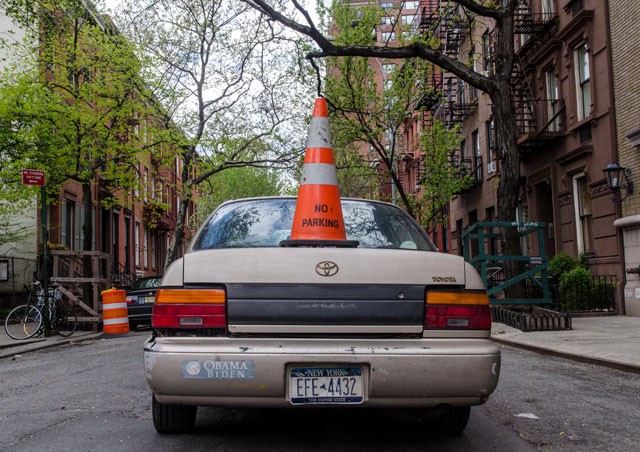
Formisano, who is fifty eight, has lived in the neighborhood his entire life. Although some call it Carroll Gardens or its more gentrified name, the Columbia Waterfront District, Formisano assures me that we are in Red Hook. “They had mob here, gangsters,” Formisano said of his childhood. “If you didn’t break someone’s face, your face would be broken.” After retiring, Formisano, a former bail enforcement agent who had started his own security business, found himself undertaking small improvements on the block: planting and pruning trees, picking up leaves, and plowing the street after a snowfall. He tackled larger projects, too, like cleaning out an abandoned lot at the end of the block that was overgrown with weeds and full of trash. He also brought in a small pool for the local kids to swim in during summer. “I take care of everybody on the block,” Formisano said with a proud smile. “I’m a silent employee of the city.”
Formisano found that the greatest need for some of the block’s residents was dealing with the parking regulations and he began offering to move his neighbors’ cars for them, so that they didn’t have to worry about taking time off work. Having worked in law enforcement, Formisano knows many of the local police, so they do not interfere with his routine. “It gives you the opportunity to park the car where you live,” Formisano said of the arrangement. “One guy brought a brand new car because of me.”
Formisano shares something in common with most New Yorkers who chose to park their cars on the city’s streets: He is someone with a little extra time. Because dealing with alternate-side parking takes so much of it, most people who regularly park on the street have some flexibility in their schedules; they are working and middle class people who have managed to earn enough money to live in the city and own a car, but don’t have sufficient disposable income to pay for a garage or a house with a driveway. (Others, like cab drivers and deliverymen with cars, don’t have any choice but to park on the street). The New York residents who talked about parking with me included a superintendent at an apartment building, a psychotherapist, a retired beautician, and my father, an artist who runs a picture frame business.
“It’s time that I have to relax and think,” Helena Barthell, a woman I met sitting in her double-parked SUV on a sunny day on the Upper West Side, told me. Barthell recently moved to New Hampshire with her husband, but the two frequently return to the city to visit family, and during those trips, Barthell takes on her old parking responsibilities. While waiting for the sweeper to come by, she often listens to books on tape and prays while holding her rosary beads. She notes that the alternative is paying six hundred dollars a month for a space in a parking garage. “I view this as my job,” she says. “This is what they are paying me for.”

The idea that a parking space is a thing with an economic value has recently motivated a trove of scholarship critical of municipal parking policies, especially in New York City. “I don’t know of any other big city that throws up its hands and says there is nothing we can do about parking,” Donald Shoup, a professor of urban planning at UCLA, told me. Shoup, who authored the book “The High Cost of Free Parking,” views free parking in New York and other cities as a classic “tragedy of the commons” problem, in which a resource is free to the public and, as a result, becomes overused. Free parking causes an overuse of cars, Shoup contends: A block may have fifty parking spots, but sixty people want them. The end result is that ten people are keep circling the block, looking for another place to leave their car.
There are a lot of people driving around looking for parking spots. The group Transportation Alternatives, which is dedicated to the reduced use of cars in New York City, found that twenty-eight per cent of traffic in Soho and forty-five per cent of traffic in Park Slope consisted of people just looking for a place to park. (A study of west Midtown came up with a lower figure of eight per cent.) The consequence of this searching is more than just a waste of time: More traffic means more pollution, higher emissions, and less clean air. It also means more traffic congestion and more car accidents. More than fifteen thousand pedestrians and cyclists were injured by cars in New York City in 2012, and two hundred and seventy people were killed in car accidents that year. At least some of these accidents involved drivers searching around for parking.
To Shoup and others, there is a simple solution, one that was recognized by the angry magistrate judge back in 1933: Charge for parking. The goal, explains Shoup, is to set a price that would deter driving to the extent that there would always be one or two available spots on each block. In business areas, this could mean charging a variable price for parking. San Francisco has experimented with this in a program named SFpark, which uses sensors installed along certain curbs to tell whether the space is occupied. If spots on the block are full, the meters increase the price of parking; if a block is mostly empty, the prices drop.
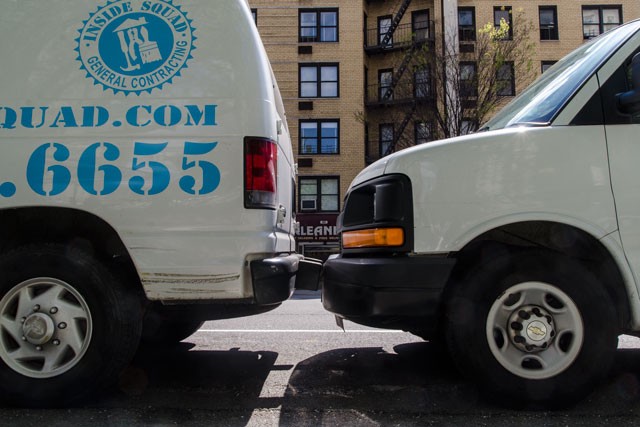
In residential areas, Shoup recommends a permit system, with the price of a residential permit determined by the demand, perhaps set by auction. The number of permits sold would be about equal to the number of spots available in the neighborhood; the sales figures should be set just low enough to ensure that there is an average of one empty parking space on every block. The benefits of such a system would be more than cleaner air and better traffic flow, Shoup notes; it would produce significant revenue for the city. “It ought to be easy as possible politically,” he said. “You need to recognize the local costs and benefits. You cannot sell a good policy on the grounds of reduced global warming alone.”
There would be some real losers. The point of this type of reform is to take a scare resource that is currently allocated by time — those who are willing to wait the longest for a spot get it — and instead allocate it by capital. The only way to get more parking spaces on the street would be to force some people who currently park on the streets to stop doing so, and those people would be drivers with the lowest incomes. Many who rely on their cars for commuting wouldn’t be happy to hear that they had to switch to less convenient public transit. And while a hundred and fifty dollars a month for a space might seem reasonable in a city where real estate is so expensive, in the Manhattan neighborhoods where the cost of a garage space routinely goes for six hundred dollars a month, it’s not hard to imagine auctions producing prices near those levels.
There is another implication of enacting a policy that would end the difficulty of finding a parking spot in New York City: that the New York culture of parking — the spot-finding strategies, the trading of spaces, the ad hoc parking block associations — is, in truth, a societal waste. Like graffiti In the age of law-and-order New York, this culture wouldn’t exist if the city were properly managed.
Toward the end of my parking tour with Mary Norris, she told me that a parker on one of her regular blocks once passed out parts of an aloe plant as a gift to his fellow parkers as they waited for the alternate-side period to pass. She used it to plant her own aloe plant. “I still have it,” she said. I wondered if she would miss this type of interaction if she no longer had to park on the street, and I asked if she would accept a free space in a garage if it meant she had to give up street parking.
“Yes,” she said after a moment. “I don’t like parking that much.”
Photos by Natalie McMullen, former resident photographer at The Awl.
